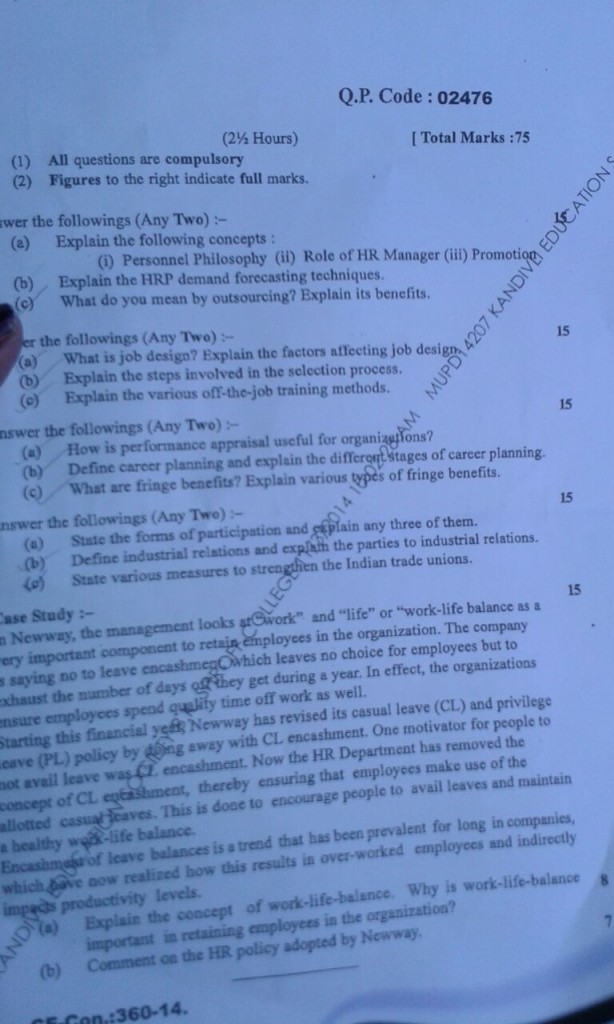Q.1 – Answer the following:
a) Explain the following concepts :
ii) Role of HR Manager
Ans: Role of today’s HR Managers
iii) Promotion
Ans: Promotion
b) Explain the HRP demand forecasting techniques.
Ans: Manpower Forecasting Techniques
c) What do you mean by outsourcing?
2 – Answer the following:
a) What is job design? Explain the factors affecting job design?
Ans:
Environmental factors affecting job design
Behavioral factors affecting job design
Organizational Factors / Elements
b) Explain the steps involved in selection process.
Ans:
Explain the steps involved in the Selection Process
c) Explain the various off-the-job training methods.
Ans:
Q.3 – Answer the following:
a) How is performance appraisal useful for organizations?
Ans:
What are the advantages of Performance appraisal?
b) Define career planning and explain the various stages of career planning.
Ans:
Explain the Process of Career Planning Programme
]c) What are fringe benefits? Explain the various types of fringe benefits.
Ans:
Write a note on Types of Fringes
Q.4 – Answer the following:
a) State the forms of participation and explain any 3 of them.
Ans:
Types of participative management
b) Define industrial relations and explain the parties to industrial relations.
Ans:
Definition of Industrial Relations
Three main parties are directly involved in industrial relations:
Employers: Employers possess certain rights vis-à-vis labors. They have the right to hire and fire them. Management can also affect workers’ interests by exercising their right to relocate, close or merge the factory or to introduce technological changes.
Employees: Workers seek to improve the terms and conditions of their employment. They exchange views with management and voice their grievances. They also want to share decision making powers of management. Workers generally unite to form unions against the management and get support from these unions.
Government: The central and state government influences and regulates industrial relations through laws, rules, agreements, awards of court ad the like. It also includes third parties and labor and tribunal courts.
c) State the various measures strengthening the Indian trade unions.
Ans:
The following are some of the measures to minimise trade union problems and to strengthen the Trade Union Movement of India.
a) United Labour Front
Unions must put a joint front. Splinter groups multiple unions dissipate their energies, dilute their power and reduce their effectiveness. Trade unions should form a sort of labour party and all the trade unions in the country should be affiliated to it. It givesadequate strength to the trade unions both industry and Parliament.
b) Efficient Leadership
Outside political leadership has developed due to the absence of internal leadership. Outside leadership is the main cause for the multiple problems of the trade unions.These problems can be eradicated through the development of leadership talents from within. Management should encourage internal workers to lead their own movement. Management and trade unions should provide educational and training facilities for the development of internal leadership.
c) Membership Fees In order to make members updated Trade unions must organise continuous training and developmental programmes. Future needs smart and responsive TradeUnions, if they have to survive and thrive.
d) The Trade Union Act should be amended in order to avoid dual membership.
e) There should be legal provision for the recognition of the representative union.
f) Unions should not intervene in day-to-day matters. They must focus on important issues affecting workers.
Q.1) i) Personnel Philosophy
Ans:
Personnel actions in any organisation are guided by the philosophy which a company may profess for
dealing with people. Such a policy may be written or may not be written; but it exists, if not openly, at
least in an inforrmal or sub-conscious manner.




In text book of Vipul ‘Stages in CAREER PLANNING ‘ is given 10 steps, whereas in ‘Stages in CAREER DEVELOPMENT’ is given the 5 above mentioned stages. The question asked was ‘Stages in CAREER PLANNING’ so how can the ans be 5 stages, it should be those 10 steps according to Vipul Publication.
Career planning itself is a process, how can they be the stages of just CAREER? Planning Is a process and the answer given by bms team is the stages of career and not career planning. I would really appreciate an explaination as to why the answer should be the stages and not the career planning process. Thank you.
according to vipul textbook it is process not stages
The ans for career planning stages is different !! They have asked for career PLANNING STAGE and not the career stages both are different..
yes thanks, the answer has been updated
Thanks a lot 🙂